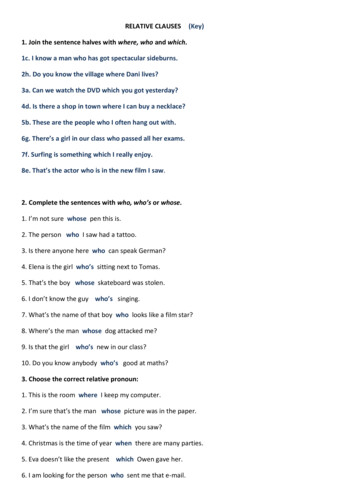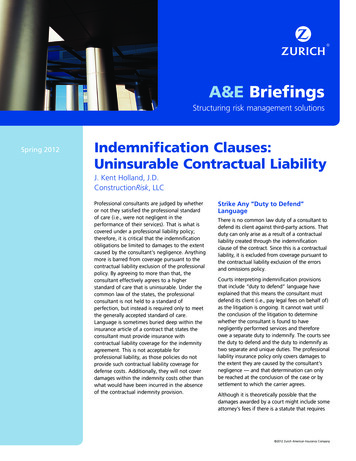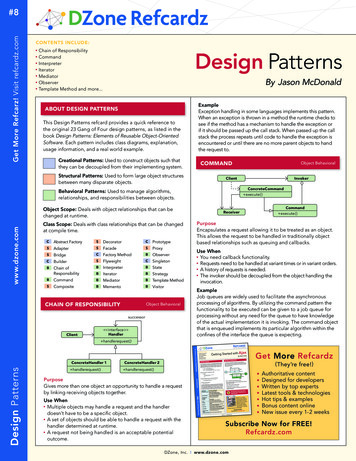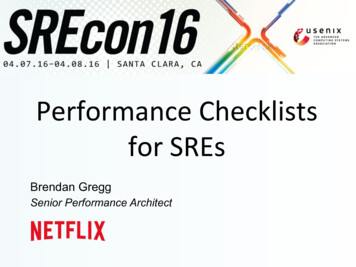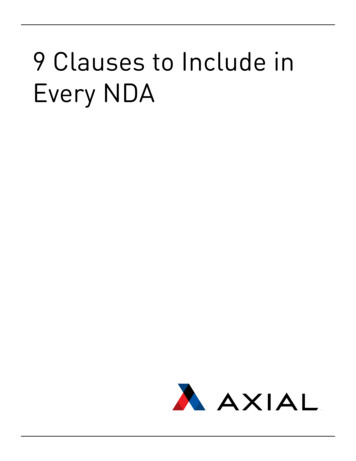
Transcription
9 Clauses to Include inEvery NDA
IntroductionNDAs have become so commonplace in middle market transactions, that many dealprofessionals have begun overlooking their importance.However, proper management of and behavior during the NDA can be an early indicatorof what the entire negotiation process will be like. Additionally, any cavalier treatment ofthe NDA could result in legal headaches down the road. To bring the focus back on thiscritical legal document, we are launching a guide that explores the NDA and. Types and uses of NDAsStrategies in NDA negotiation9 clauses that should be includedInsights from lawyers and deal professionalsAbout AxialAxial is an online network where private companies connect with capital. Owners,advisors, investors and acquirers of private companies join Axial to confidentiallyconduct business development, identify partners, and to originate and execute financialtransactions. Our mission is to help every private company access qualified advice andcapital to successfully grow or exit their business.Learn more about AxialThousands of Members use Axial everyday to connect with professionals who run,advise, finance, and acquire companies.Click here to learn more about AxialNDAIntroduction to NDA — 2
TABLE OF CONTENTS1) Getting Started. 4NDA 101 . 4Types of NDAs . 5Notes on Negotiations .62) 9 Clauses to Include. 7Definition of Confidential Information. 7Term of Confidentiality. 9Disclosure / Representatives. 9Use of Confidential Information. 10Compelled Disclosure / Legal Obligation to Disclose. 11Return / Destruction of Confidential Information. 12Remedies. 13Interaction with Employees. 13No Binding Agreement for Transaction. 15
GETTING STARTEDBefore diving into the specifics of the NDA, it is important to understand theoverall value of the NDA and when it should be used:NDA 101A Non Disclosure Agreement (NDA) is a legal document that protects anyconfidential information, and the nature of the discussions, from beingdisclosed to a third party. As Eric H. Wang of DLA Piper defined, “Theagreement is designed to protect the confidentiality of information exchangedin connection with the consideration and negotiation of the transaction andinformation exchanged in the course of a party’s due diligence review of theother.”While some deal professionals have mixed feelings about the document, mosttransactions begin with an NDA. If there is any question of confidentiality orthe importance of the information being shared, it is advisable to use an NDA-- and seek a lawyer’s help in its construction and negotiation.In most transactions, the disclosing party is the business seeking capital orinvestment and the receiving party is the investor.NDAIntroduction to NDA — 4
Types of NDAsNDAs are typically structured in one of two formats: one-way or mutual.In a one-way NDA, also known as a unilateral NDA, only one party isdisclosing information and the receiving party of the confidential informationis bound to protect that information. For example, in most transactionswith financial sponsors, the investor signs a one-way NDA protecting anyconfidential information revealed by the target company during the duediligence process. However, any information shared by the financial sponsoris not covered by the contract. Most often, the disclosing party (the seller)prepares the one-way NDA.By contrast, in mutual NDAs, also known as bilateral NDAs, both partiesdisclose confidential information and both are held accountable for thatconfidential information. These types of agreements are more appropriatefor joint ventures or strategic investments. For example, if a competitorapproaches an industry peer at a trade show, they may insist on a mutual NDAto prevent their confidential information from being leaked. In this case, anyconfidential information that is disclosed by either party is protected by theNDA.NDAIntroduction to NDA — 5
Note on NegotiationsEvery transaction is different -- and as a result, every NDA should be different.Most importantly, the negotiating parties can be very different and, as a result,it is important to be open to negotiation and discussion for a specific NDA.“From a bidder’s perspective, it is important to keep in mind that a first draft ofa confidentiality agreement is generally negotiable, notwithstanding any claimsby [the seller] that the draft is a ‘standard form’ or that every bidder is beingasked to sign the same,” said Igor Kirman in his book M&A and Private EquityConfidentiality Agreements Line by Line.Inflexibility can also scare away potential investors. “We will not move pastthe first stage of a deal if the banker or broker is not willing to accept changesto an NDA that is otherwise one-sided and not market-based,” said LeeMiklovic of Opus Capital Partners. “The unwillingness to incorporate edits andchanges ultimately reduces the number of higher quality, prospective buyersand ultimately hurts the client. Private equity firms that are in the business ofreviewing deals on a recurring basis will have certain minimum standards.”As it turns out, Miklovic has historically “passed on 25% of deals becauseof the language in the NDA, the rigidity to changes, or time required to makesuch changes.” Behavior during the NDA can be an early indicator of what theentire negotiation process will be like -- while it is not advisable to include unfairclauses in the NDA, it creates a challenging environment to be too rigid.Behavior during the NDA can be an early indicatorof what the entire negotiation process will be like-- while it is not advisable to include unfair clausesin the NDA, it creates a challenging environmentto be too rigid.NDAIntroduction to NDA — 6
9 CLAUSES TO INCLUDETo understand the importance of the NDA, and why you should be focusing onthis critical document, below are 9 elements that should be included in everysingle NDA:1) Definition of Confidential InformationThe definition of ‘confidential information’ can and should vary based on thespecific transaction. As such, it is critical for every NDA to first and foremostclearly define the materials that should (and should not) be consideredconfidential. Materials include, but are not limited to, oral conversations,written notes, analysis, and documents produced with the use of theconfidential information. Special mention should be made for any materialsthat are considered to include ‘trade secrets’.Generally, the “disclosing party will likely prefer a broad definition andshould resist the need to mark or otherwise identify information as beingconfidential,” explained Andrew Lord and Ted Maduri of Davis LLC. By castingthe widest possible net for confidentiality, the disclosing party receives thegreatest benefit of the contract.For the same reason, the “receiving party will likely prefer a narrower definitionas to what would constituteconfidential information,” remarkedLord and Maduri. Many receivingparties will narrow the scope ofthe contract to only very specificitems -- like information relatingto products, services, markets,customers, research, software,developments, inventions, designs,drawings, financials -- and requestthat all confidential material bemarked confidential.NDAKey Terms — 7
If there is a dispute over the definition of confidentiality, the 1991 caseof Pharand Ski Corp. v. Alberta has helped establish a precedent ofconsiderations for confidentiality:1. the extent to which the information is known outside the owner’sbusiness2. the extent to which it is known by employees and others involved in theowner’s business3. the extent of measures taken by him to guard the secrecy of theinformation4. the value of the information to him and his competitors5. the amount of money or effort expended by him in developing theinformation6. the ease or difficulty with which the information could be properlyacquired or duplicated by othersIt is equally as important to define what is notconfidential. For many transactions, someinformation cannot reasonably be expected toremain confidential, given certain circumstances,and must be outlined in the agreement.In addition to defining what is confidential, it is equally as important to definewhat is not confidential. For many transactions, some information cannotreasonably be expected to remain confidential, given certain circumstances,and must be outlined in the agreement.Examples of information that are often excluded from an NDA include, but arenot limited to, publicly available information, information lawfully known priorto receiving it from the disclosing party, information lawfully received froma third party on a non-confidential basis, and compelled disclosure (furtherdiscussed below).NDAKey Terms — 8
2) Term of ConfidentialityIn addition to defining confidentiality, all NDAs should also clearly define a timelimit for the agreement. The term can be one year, two years, five years, or foran indefinite term. Whatever the choice term, it is critical to clearly define it.For most sellers, the longer the term of the NDA, the better -- especially if‘trade secrets’ are being disclosed. Depending on the nature of the disclosingparty’s business, the ‘trade secret’ may be just as critical in 25 years as it istoday. As such, they will seek to protect and secure confidentiality for thatinformation for as long as possible.However, few financial sponsors or receiving parties will sign an indefinite orvery long-term NDA; it can leave them legally vulnerable or limit their abilityto make investments after the close of their due diligence process. “Mostpotential buyers prefer a time period of 18 months, but no more than twoyears,” explained Miklovic.3) Disclosure / RepresentativesThe next item to include inany NDA is the disclosures/ representatives clause.In this clause, the NDAshould define with whom theconfidential information maybe disclosed.This clause is particularlyimportant for financialtransactions. Typically,financial sponsors will have a variety of employees, attorneys, accountants,consultants, financing sources, and other portfolio companies review thedisclosed information. Ensuring access to the confidential information forthese parties is critical for comfortable due diligence and analysis.NDAKey Terms — 9
To create an appropriate representative clause, the types of representativeswith which the recipient intends to share the confidential information shouldbe outlined. While it may be tempting to cast a very wide net of includedrepresentatives, being vague in this clause can leave significant areas ofinterpretation -- and create tension with the discloser, who generally prefers tohave a smaller group of representatives.Regardless of the specific parties named in the clause, most NDAs typicallyrequire, “that the potential buyer inform all recipients [and representatives]of the terms and conditions of the non-disclosure agreement,” explainedSchmelter, Klein, and Springer of Venable. “In some cases, there is an explicitrequirement that the representatives agree to be bound by the terms of thenon-disclosure agreement prior to receiving any confidential information.” Inother words, all representatives must know the information is confidential andthe clauses to which they are bound.4) Use of Confidential InformationOne of the trickiest clauses in the NDA is the “Use of Confidential Information”clause. This section is meant to provide clarity around the intended use ofthe confidential information. For most standard M&A NDAs, the confidentialinformation is limited only for evaluationand negotiation of the potentialtransaction.While the clause may seem simpleenough, the problem arises with the‘doctrine of inevitable disclosure.’ StephenO. Meredith of Edwards & Angell, LLPexplains, “The theory is that, despite thebest of intentions the executive’s head isso filled with confidential information aboutthe prior [firm] that it would be literallyNDAKey Terms — 10
impossible not to disclose (even unintentionally) or misuse that information.”Inevitable disclosure, while not appropriate for all instances, has beensuccessfully used in few recent court cases -- including Goodrich CapitalLLC v. Vector Capital Corporation, Martin Marietta Materials, Inc. v. VulcanMaterials, and RAA Management, LLC v. Savage Sports Holdings, Inc.For the recipient of the disclosed information, the best strategy is to have nolimitations on the use of the confidential information. However, few businessowners would feel comfortable with that much openness built into thecontract. Instead, some recipients prefer using a shorter term for the NDA tohelp mitigate the issue.5) Compelled Disclosure / Legal Obligation toDiscloseWhile an NDA is signed to prevent the disclosure of confidential informationto third parties, such an event is occasionally unavoidable. Necessaryexceptions to the NDA must applywhen disclosure is mandated byadministrative or legal proceedings.“Although a recipientFor example, if a financial sponsorcan do much to protectis being investigated by the SEC, itthe confidentiality of themay have no choice but to share theconfidential documents.discloser’s confidentialinformation, there isn’tAs Pendulum Legal explained,much it can do if the“Althou
Our mission is to help every private company access qualified advice and capital to successfully grow or exit their business. Click here to learn more about Axial Learn more about Axial Thousands of Members use Axial every day to connect with professionals who run, advise, finance, and acquire companies. About Axial Introduction NDAs have become so commonplace in middle market transactions .
